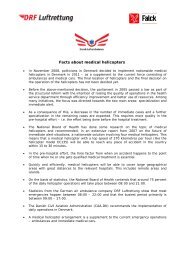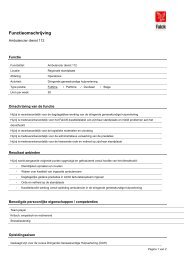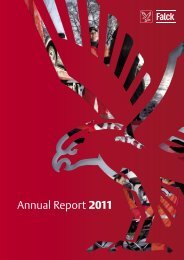Annual Report 2010 - Falck
Annual Report 2010 - Falck
Annual Report 2010 - Falck
You also want an ePaper? Increase the reach of your titles
YUMPU automatically turns print PDFs into web optimized ePapers that Google loves.
60 <strong>Falck</strong> <strong>Annual</strong> <strong>Report</strong> <strong>2010</strong> | Group<br />
Notes to the Group financial statements<br />
Note<br />
1 Accounting policies (continued)<br />
Revenue is measured at the fair value of the agreed consideration<br />
excluding VAT and other taxes collected on behalf of third<br />
parties. All discounts granted are recognised in revenue.<br />
Other operating income represents revenue of a secondary<br />
nature relative to the Group’s principal activities, such as gains<br />
on the sale of assets and rental income.<br />
Cost of sales and external assistance represents costs incurred<br />
and external assistance used to generate the year’s revenue.<br />
Other external costs include costs relating to operating and<br />
maintaining equipment and property as well as sales and<br />
administrative expenses.<br />
Staff costs represent salaries and wages, pension contributions,<br />
social security costs and other staff costs.<br />
Goodwill impairment represents impairment of goodwill based<br />
on an annually performed impairment test of each cashgenerating<br />
unit.<br />
Exceptional items represent material items of a non-recurring<br />
nature that are not directly attributable to the Group’s ordinary<br />
activities.<br />
Income from investments in associates in the consolidated<br />
financial statements represents the proportionate share of<br />
the results after tax in the associates, made up according to<br />
the Group’s accounting policies and after elimination of the<br />
proportionate share of intra-group profits/losses.<br />
Dividend from Group companies is recognised in the parent<br />
company’s income statement in the financial year in which<br />
the dividend is declared. An impairment test is made if more<br />
than the period’s comprehensive income in subsidiaries and<br />
associates is distributed in the period in which the dividend is<br />
declared.<br />
Financials represent interest receivable and payable, realised<br />
and unrealised capital gains and losses and amortisation<br />
related to financial assets and liabilities. Dividends to capital<br />
holders who have received put options in connection with<br />
business combinations are recognised as a financial expense<br />
in the cases where the option price is independent of dividend<br />
payments. Financials are recognised at the amounts related to<br />
the year. Furthermore, realised and unrealised gains and losses<br />
on derivative financial instruments which cannot be classified<br />
as hedging arrangements are included.<br />
INCOmE TAXES<br />
Tax on the profit for the year represents corporation tax<br />
payable and changes in deferred tax. Tax for the year that is<br />
attributable to amounts recognised in other comprehensive<br />
income is recognised in other comprehensive income.<br />
Joint taxation<br />
The parent company is taxed jointly with its domestic subsidiaries.<br />
Corporation tax for the jointly taxed Danish companies<br />
is allocated according to the taxable income of these<br />
companies.<br />
<strong>Falck</strong> A/S is the management company for the national joint<br />
taxation and consequently settles all payments of income<br />
taxes with the tax authorities in respect of the jointly taxed<br />
companies.<br />
Income taxes payable<br />
Corporation tax payable includes corporation tax made up on<br />
the basis of estimated taxable income for the financial year<br />
and prior-year adjustments.<br />
Deferred tax<br />
Deferred tax is calculated according to the balance sheet liability<br />
method and is based on all timing differences between the<br />
accounting and tax value of assets and liabilities.<br />
Deferred tax is not recognised on goodwill that is not tax<br />
deductible, and deferred tax is not recognised on undistributed<br />
profits in subsidiaries and timing differences that arose<br />
at the time of recognition in the balance sheet other than for<br />
acquisitions if such differences will not affect profit or taxable<br />
income.<br />
When alternative tax rules can be applied to determine the<br />
tax base, deferred tax is measured based on the management’s<br />
planned use of the asset or settlement of the liability<br />
respectively.<br />
Deferred tax assets, including the tax base of tax loss carryforwards,<br />
are recognised under other non-current assets<br />
at the expected value of their utilisation, either as a set-off<br />
against tax on future income or as a set-off against deferred<br />
tax liabilities within the same legal tax entity and jurisdiction.<br />
Deferred tax assets and liabilities are offset within the same<br />
legal tax unit or jurisdiction. Deferred tax assets are measured<br />
at the value at which they are expected to be realised.
















